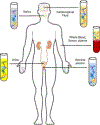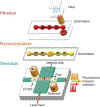Advances in liquid biopsy on-chip for cancer management: Technologies, biomarkers, and clinical analysis
- PMID: 29388456
- PMCID: PMC6101655
- DOI: 10.1080/10408363.2018.1425976
Advances in liquid biopsy on-chip for cancer management: Technologies, biomarkers, and clinical analysis
Abstract
Liquid biopsy, as a minimally invasive method of gleaning insight into the dynamics of diseases through a patient fluid sample, has been growing in popularity for cancer diagnosis, prognosis, and monitoring. While many technologies have been developed and validated in research laboratories, there has also been a push to expand these technologies into other clinical settings and as point of care devices. In this article, we discuss and evaluate microchip-based technologies for circulating tumor cell (CTC), exosome, and circulating tumor nucleic acid (ctNA) capture, detection, and analysis. Such integrated systems streamline otherwise multiple-step, manual operations to get a sample-to-answer quantitation. In addition, analysis of disease biomarkers is suited to point of care settings because of ease of use, low consumption of sample and reagents, and high throughput. We also cover the basics of biomarkers and their detection in biological fluid samples suitable for liquid biopsy on-chip. We focus on emerging technologies that process a small patient sample with high spatial-temporal resolution and derive clinically meaningful results through on-chip biomarker sensing and downstream molecular analysis in a simple workflow. This critical review is meant as a resource for those interested in developing technologies for capture, detection, and analysis platforms for liquid biopsy in a variety of settings.
Keywords: Liquid biopsy; cancer biomarker; biosensor; lab-on-chip; point of care.
Figures

















References
-
- Tadimety A, Syed A, Nie Y, Long CR, Kready KM, and Zhang JXJ, “Liquid biopsy on chip: a paradigm shift towards the understanding of cancer metastasis,” Integr. Biol, vol. 64, pp. 9–29, 2017. - PubMed
-
- Siegel RL, Miller KD, and Jemal A, “Cancer Statistics, 2017,” vol. 67, no. 1, pp. 7–30, 2017. - PubMed
Publication types
MeSH terms
Substances
Grants and funding
LinkOut - more resources
Full Text Sources
Other Literature Sources
Miscellaneous
